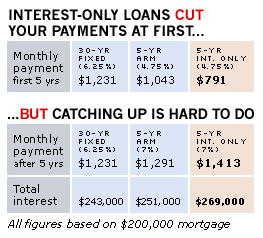BEND, Ore. (CNN/Money) -
You started house hunting when interest rates were at their very lowest. Now that they've increased by more than a percentage point, your $300,000 home budget has suddenly shrunk to $250,000.
Enter interest-only loans. As the name suggests, you pay only interest for the first five, 10, even 15 years of the loan, thereby lowering your monthly payment by quite a lot. At least initially.
"We've seen a dramatic pickup in these loans since rates starting going up," said Anthony Hsieh, CEO and founder of HomeLoanCenter, an online mortgage provider in Irvine, Calif. Hsieh added that one in seven loans processed by his company is an interest-only product.

"People who calculated what they could afford when rates were 5.25 percent have realized their mortgage payments are going to be a lot higher now that rates have gone up, so they're going for interest-only loans."
Problem is, once you do begin paying principal, you'll have to play catch-up to pay down your debt before your term is up. That means your payments are much higher than they would have been if you'd simple chipped away at the balance of your loan all along.
"These loans can be of value for people who want to save or invest the money they would have paid in principal," said Keith Gumbinger, vice president for HSH Associates, a publisher of loan information in Butler, N.J.. "Unfortunately, the way the product has been pitched, borrowers have been encouraged to stretch their budget to buy more house."
The math says it all
Interest-only loans come in all flavors. With some, you lock in a fixed interest rate for the life of the loan, while others resemble adjustable rate mortgages, which carry a fixed rate for a certain number of years and then adjust every six months to a year.
According to Hsieh, the most popular interest-only product resembles a 5-year adjustable-rate mortgage but requires that you pay only interest, no principal, for the first five years.
The initial savings is pretty impressive.
Let's say you borrow $200,000 using an interest only loan with a 4.75 percent rate and no principal payments due for five years. Your monthly payment will be just $791, or about $250 a month less than if you went with a regular 5-year adjustable rate mortgage with the same rate.
For more help with household finance, click here
Compare this interest-only loan with a 30-year fixed loan of 6.25 percent, and your savings are $440 a month. That adds up to $26,000 in lower monthly payments for the first five years of the loan.
"If you're the gambling sort, you could get into an interest-only product and bet that the market will build equity for you," said Gumbinger, explaining that paying down principal is not as much of a concern for people with shorter time horizons, particularly if home prices are going up.
Of course, there's never a guarantee that prices will appreciate. And if you stay in the house longer than you planned, your monthly payment jumps drastically after your five-year honeymoon period. Suddenly you have to pay principal on the loan, and most likely at a higher rate. If your rate goes to 7 percent for the life of the loan (and there's nothing stopping it from going higher), your payments will nearly double to $1,413.
"Clearly these loans aren't for everyone," said Hsieh. "Unless you've been disciplined about saving the difference you're setting yourself up for sticker shock at the end of five years."
In fact, if an interest-only loan is the only way you'll afford your dream house, you should think twice.
"The people who are taking these loans because it's the only way they can afford their house are exposing themselves to a lot of risk," said Ric Edelman, a financial adviser and author. "They're not saving money and they're not building equity, which means they could find themselves in a scenario where they owe more money than their house is worth."
For some, a smart strategy
This is not so say the interest-only loans should be avoided at all costs.
Edelman, for one, has incorporated an interest-only loan into his overall financial plan. About a year ago he opted for an interest-only loan with a 4.25 percent rate for the first five years. "It's a low rate and it's 100 percent tax deductible," he said.
| Related articles and tools
|

|
|
|
|
But unlike a lot people with interest-only loans, Edelman wasn't looking to buy a more expensive house than he can afford. Rather, he saw an opportunity to invest the money he'd otherwise pay in principal. "The strategy is to get your payment as low as possible and free up extra cash to invest, and I'm convinced that I'll be able to make more from investments than loan is costing me."
When his payments do go up after five years, he knows he can afford the extra payment.
If you go the interest-only route, you're wise to set up an automatic deduction to an investment or savings account. Doing so will dampen the risk that you spend your savings and make it easier to swallow higher payments down the road.
Interest-only loans also make sense for people whose income is sporadic, either because they are paid on commission or because they receive annual bonuses. In this case, they have the option of only paying interest some months but can pay above and beyond the amount due when they get their bonus checks. According to Hsieh, there is typically no prepayment penalty on interest only loans.
Of course, this kind of strategy also requires that you're disciplined enough to sign your bonus check off to your lender rather than taking it to the Caribbean.

|

